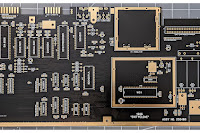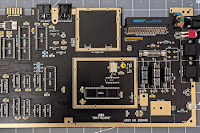
In this article I want to talk about lens diffraction and as always I will give a simple explanation as to what it actually is, what causes it and give examples.
In my article The Exposure Triangle I wrote about aperture settings, and how your chosen aperture would affect your depth of field. Without repeating everything I wrote there, it's enough to remember that I stated a small aperture (e.g. f/22) gave a larger depth of field (i.e. more of the scene will be in focus) than a larger aperture (e.g. f/4).
Now while that is completely true, there is another issue that arises when you use smaller apertures and this is called diffraction. As we have already discussed, light travels in waves. When these waves hit the lens on your camera they are bent a little. In addition to this, when light travels through a small hole, i.e. your aperture, it bends again and starts to disperse. The smaller the hole, the more the light is dispersed. When light disperses it means that it is no longer properly in focus as it hits the camera sensor and the result is that the image is slightly fuzzy. This is diffraction.
To demonstrate this I took two of the pictures of my prop Kingfisher: 1 picture taken at an aperture of f/8 and another taken with an aperture of f/22. Otherwise the pictures are identical. I have enlarged a tiny portion of the picture by 200% and created a short animation which moves back and forth between the two. The result is quite revealing:
 |
| Animation demonstrating the effects of diffraction |
Overlaid on top of each other and blended it is easier to see the difference than if I had put the pictures side, by side. If you are viewing this on a mobile phone the difference between the two apertures may not be obvious but if you are viewing on a computer you should be able to see quite clearly that as the animation loops it moves from fuzzy to sharp(ish). The sharper image was taken at an aperture of f/8; the blurrier of the two was taken at f/22 and this difference is wholly down to diffraction.
Now in this particular picture I did have to zoom in a lot to actually see the difference. In the original images when viewed on the internet at a reduced size the difference just wasn't visible at all so once again, whether diffraction is worth worrying about really does depend on the final use of the image. For small, standard prints and social media usage I would suggest it's not worth worrying about. Period. If however, you're making very large prints then yes, absolutely, it's something you will need to consider.
Each lens and camera combination will demonstrate different effects of diffraction and it's impossible to say what are the best settings for you. Once again the key to finding out what works is to experiment with your own camera. Do what I've done and mount your camera on a tripod and take a picture of an object (this is why I use props) and experiment with different apertures. Then do the same again with objects at different distances. That way you'll start to understand how your camera behaves and when you're in the field photographing Kingfisher's (or any other subject) for real, you'll have a better understanding of precisely what settings will give you the sharpest picture.
Please bear in mind, it's extremely unlikely you'll ever be taking wildlife pictures at really small apertures like f/22 - the resultant long shutter speeds would make it useless. But in landscape photography, to maximise your depth of field (i.e. the part of your image which is in focus), you may wish to use a small aperture so it's an experiment worth conducting with your camera, at different apertures to see the effects. Does f/4 produce less diffraction than f/5.6 or f/8? Is the difference indiscernible? You'll never know unless you experiment.



